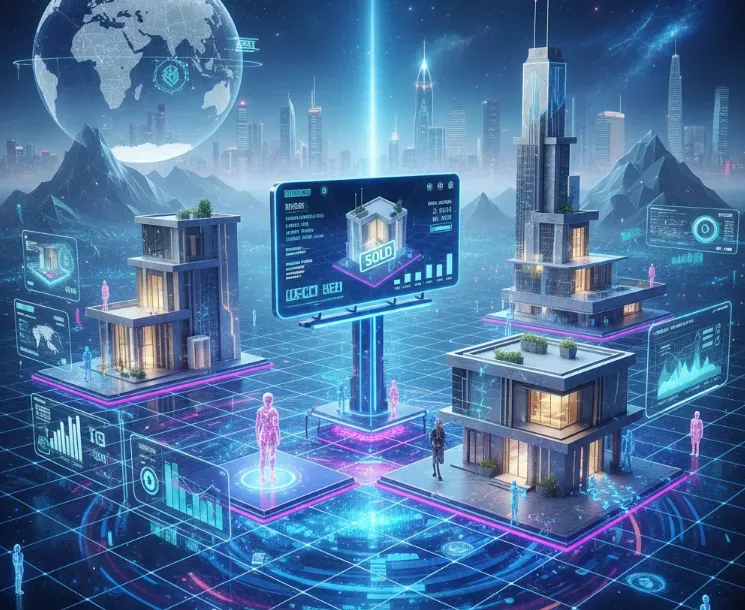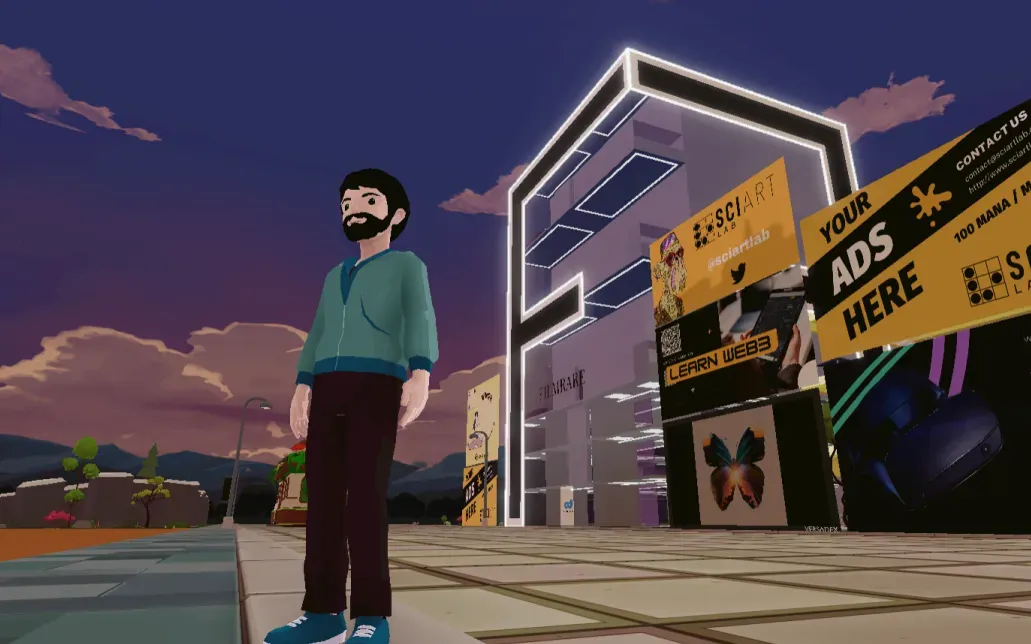Metaverse & Real Estate: Is Virtual Property the Next Big Investment?

By
Shrusti Naik
Posted on September 30, 2025. 10 mins

Introduction

The metaverse, once a speculative sci-fi idea, has swiftly moved from the fringes into boardroom conversations. Its potential to reshape how we live, work, and interact is enormous. One of the most intriguing domains is real estate, not just physical property but virtual property, parcels of digital land inside virtual worlds.
In 2025, investors, developers, and technologists in India and globally are asking: Could virtual real estate become a serious asset class? This blog explores that question. We’ll examine how virtual property works, its intersection with physical real estate, Indian trends, opportunities, risks, and whether it merits a place in your portfolio.
1. What Is Virtual Real Estate in the Metaverse?
1.1 Defining Virtual Property
Virtual real estate refers to digital parcels, “land” in metaverse platforms like Decentraland, The Sandbox, Somnium Space and others, denoted as NFTs (non-fungible tokens). Owners can build, rent, trade, or host experiences on these lands. [15][8]
Unlike physical property, virtual land has:
- No physical presence, exists purely in digital worlds
- Ownership enforced via blockchain (NFT) rather than title deeds
- Dependence on platform continuity (if the platform shuts down, value may vanish)
A recent empirical study observed that returns in virtual land markets were largely independent from traditional real estate returns, meaning virtual property behaves as its own asset class. [13] Moreover, take a look The Unseen Costs of Homeownership: Beyond EMI and Property Tax
1.2 Market Size & Trajectory
- India’s metaverse market was valued at USD 11.20 billion in 2024 and is projected to reach USD 18.20 billion by 2030 (CAGR ~8.27%) [5]
- Globally, aggressive forecasts suggest some metaverse real estate segments could grow at 30+% CAGR (though such numbers are speculative) [15]
- Platforms such as Decentraland list over 90,601 virtual parcels, with ownership recorded in Ethereum-based NFTs. [27]
These signals point toward growing interest and investment in the virtual land domain.
2. How Does Virtual Real Estate Relate to Physical Real Estate?
It may seem counterintuitive, but virtual and physical real estate overlap in several meaningful ways:
- Showcasing & marketing: Real estate developers in India now use metaverse / VR twin environments to let prospective buyers walk through homes virtually, reducing geographic friction. [12]
- Tokenization of physical assets: Parts of real buildings may be tokenized as fractional NFTs, merging virtual ownership with real world property rights.
- Brand extension: Developers may build virtual versions of their real projects to create brand affinity, virtual tours, or immersive marketing.
- Overlay value correlation: While virtual real estate returns have some independence, major real estate players see metaverse presence as value-adding brand capital.
Thus, we are not talking about real and virtual worlds in silos, they increasingly intertwine. Check out this Property Management for NRIs: A Seamless Guide to Handling Your Indian Assets from Abroad
3. Indian Developments & Use Cases
3.1 Real Estate Metaverse Firms in India
Several Indian proptech and VR/AR firms are already active:
- SmartVizX builds VR / immersive tools (Trezi) for real estate visualisation. [4]
- Square Yards offers 3D / metaverse-style virtual tours and staging for Indian property listings. [4][12]
- Abhiwan Technology is creating full metaverse real estate platforms in India, allowing 360° walkthroughs and virtual property experiences. [4]
These companies are laying the foundation for virtual property ecosystems tied to Indian real estate. You may want to check Understanding Real Estate Taxes
3.2 Policy & Infrastructure Enablers
- Maharashtra has approved an AVGC-XR (Animation, Visual Effects, Gaming, Comics, Extended Reality) Policy 2025, allocating ₹3,268 crore to build XR / metaverse infrastructure parks. This may catalyze virtual real estate development in Mumbai & surrounding areas. [0news23][0news21]
- Indian regulatory and legal frameworks are still catching up—there is no specific statute for virtual property, so platforms must rely on existing digital / blockchain / contract law.
4. Why Investors Are Paying for Virtual Real Estate
What attracts capital to such intangible property? The motivations include:
- Scarcity & novelty: Many metaverse platforms limit virtual land parcels; first movers may capture value.
- Speculation & flipping: Early parcels in promising zones often see rapid price appreciation.
- Monetisation via digital experiences: Landowners can host concerts, art galleries, virtual stores, rent plots, or earn ad revenue.
- Brand / marketing leverage: Brands (like Gucci) are building metaverse land to engage digital audiences. [0news20][0news22]
- Diversification into a digital alternative asset: Some investors view virtual real estate as analogous to digital art, crypto, or NFTs.
Yet the “metaverse real estate boom” is volatile; success stories exist, but so do steep losses when platforms lose traction. Also read The Unseen Influence of Local Infrastructure Projects on Property Values: A 2025 Indian Playbook
5. Returns, Risks & Key Metrics
5.1 Return Drivers & Metrics
Key metrics to track in virtual property investment:
- Platform user growth / active users
- Land parcel traffic / footfall
- Offerings & monetisation opportunities (leasing, events)
- Scarcity / zoning / premium zones in the virtual map
- Liquidity & secondary market activity
Historical analyses reveal some dramatic returns: for example, the price of Sandbox LAND surged multiple fold in USD terms. But careful work (e.g., in “Is Metaverse LAND a good investment?”) shows that unit of account matters, if measured in platform native tokens vs USD, returns can differ significantly. [31]
Also, the volatility in cryptocurrency markets heavily impacts virtual land valuations.
5.2 Risks & What Could Go Wrong
| Risk | Description | Impact |
|---|---|---|
| Platform failure / collapse | If the metaverse platform fails or becomes obsolete | You may “lose” your land value |
| Regulatory / legal void | Lack of statute for virtual property | Ownership may lack enforceability |
| Speculative bubble | Prices driven by hype, not fundamentals | Sudden crashes possible |
| Liquidity constraints | Secondary markets may be thin | Hard to exit or cash out |
| Token / crypto volatility | Land priced in native tokens (e.g. SAND, MANA) | Price swings magnified by token volatility |
To illustrate: a paper found that though Sandbox LAND rose >300× in USD terms between 2019 and 2022, when measured in its native token SAND, the rise was only ~3×. [31] So currency and valuation basis matter deeply.
6. Is Virtual Real Estate the “Next Big Investment”? Reality Check
6.1 Arguments in Favor
- The metaverse market is projected to grow substantially (e.g., India’s metaverse market ~USD 11.2B in 2024 → USD 18.2B by 2030). [5]
- Real estate firms adopting virtual showrooms and immersive tours lend legitimacy to the space. [12]
- First movers can capture rare “premium zones” in virtual maps (e.g. adjacency to high-traffic nodes).
- Brands investing in virtual presence (e.g. Gucci’s land in The Sandbox) showcase use cases. [0news20][0news22]
6.2 Hurdles to Mainstream Adoption
- Absent regulation / legal clarity in India, digital property rights are still ambiguous.
- Overhype and speculative volatility could deter serious institutional capital.
- Dependency on platform success means fragility, your virtual land is only worth what the platform sustains.
- Digital divide: many Indian investors may lack crypto literacy or comfort with blockchain.
- Lack of real income backing, monetisation models are experimental.
Thus, it’s premature to declare virtual real estate as the next guaranteed big investment, but it is a high-potential frontier deserving cautious capital.
7. How You Can Participate (As an Indian Investor)
If you want to experiment, here’s a starter roadmap:
- Select stable platforms: Decentraland, Sandbox, Somnium where ecosystems are more mature.
- Understand token & fiat exposure: Know how much exposure to volatile cryptocurrencies your land value has.
- Check platform map & adjacency: Buy parcels near hubs, gateways, or high-traffic zones.
- Diversify: Don’t put all capital into one virtual world or one parcel.
- Set exit strategies: Understand listing rules, liquidity options, secondary markets.
- Compare vs physical real estate risk: Treat virtual land as a speculative allocation, not your entire portfolio.
- Monitor regulation & taxation: Taxation on NFT gains, capital gains, or income from virtual property may arise.
- Pilot with small capital: Experiment with minimal amounts to test mechanics, understand user experience.
Over time, as regulatory clarity evolves, and as blockchain governance improves, the virtual property space may become less risky. You might also like to checkout The Home Selling Checklist
Comparison Table: Virtual Property vs Physical Property
| Feature | Physical Real Estate | Virtual Real Estate |
|---|---|---|
| Tangibility | Physical, usable, generative | Digital, abstract |
| Ownership mechanism | Title deeds, registries, law | NFTs / smart contracts on blockchain |
| Maintenance & cost | Real physical upkeep, taxes | Minimal upkeep, platform maintenance fees |
| Liquidity | Often slow, months to sell | Potentially quicker via secondary markets |
| Income sources | Rent, commercial leasing | Virtual leasing, event hosting, ad revenue |
| Regulatory clarity | Mature legal frameworks | Emerging, uncertain |
| Risk type | Market cycles, physical damage | Platform risk, token volatility |
Key Stats Box
Vital Figures for Metaverse & Virtual Real Estate (2025) • India’s metaverse market (2024): USD 11.20 billion — projected to grow to USD 18.20 billion by 2030 (CAGR 8.27%) [5]
• Many Indian proptech firms (SmartVizX, Abhiwan, Square Yards) already offer virtual real estate / immersive property tours. [4][12] • Decentraland hosts ~90,601 virtual parcel NFTs in its metaverse. [27] • Empirical study shows virtual land returns are largely decoupled from physical real estate returns. [13] • Study warns valuation depends heavily on unit of account (native token vs USD), e.g. Sandbox LAND. [31]
Conclusion & Outlook

The metaverse is not a fad; it’s a budding domain reshaping how we conceive property, community, and place. Virtual real estate sits at the intersection of real estate, crypto, gaming, and digital culture. In India, the regulatory, institutional and infrastructural levers are still being built; but early movers are beginning to test the waters.
For now, virtual property should be treated as a frontier speculative investment, not a replacement for physical real estate. But for those willing to navigate token dynamics, platform risk, and regulatory ambiguity, virtual land offers a glimpse into what real estate might become in a digital future.
For those in pursuit of their dream home, investment opportunities, or a sanctuary to call their own, Jugyah provides top housing solutions with its intelligent technology.
Frequently Asked Questions
-
Is virtual real estate legally recognised in India? Not yet. Virtual property is typically governed by blockchain, contract, and digital asset law. India currently lacks a statute specifically recognising NFTs or virtual land as property.
-
How is virtual land taxed in India if I sell or earn rent? Gains from selling a land NFT are likely taxed as capital gains (short or long term depending on holding). If the land is leased or monetised, income may be taxed as business or other income. Consult a tax advisor.
-
Can my virtual land value go to zero? Yes. If the platform fails, loses users, or shuts down, your parcel may become worthless. Platform risk is real.
-
Should I treat virtual real estate as part of my real estate allocation? It’s better to treat it as an experimental / speculative allocation—a small slice of your overall portfolio rather than a core holding.
-
Can physical real estate developers use virtual land to market projects? Yes. In India, many developers already use metaverse / VR twin environments to show off under-construction properties, allowing remote buyers to “walk through” designs virtually. [12]
References
- “India Metaverse Market Size, Share and Outlook 2030F,” TechSci Research, Feb 2025. ([TechSci Research][1])
- “Real Estate in India: Unveiling the Metaverse Future,” Square Yards, Apr 2025. ([SquareYards][2])
- “Market Value or Meta Value? The Value of Virtual Land,” AG Ruggeri et al., MDPI, 2024. ([MDPI][3])
- “Virtual Land in India’s Metaverse,” RealtyNXT, Jul 2024. ([RealtyNXT][4])
- “Understanding the Concept of Metaverse Real Estate,” PropVR AI, Jun 2025. ([PropVR][5])
- “Metaverse Real Estate: Why People Are Paying for Virtual Land,” SoftProdigy. ([SoftProdigy][6])
- “Metaverse Experience in Real Estate,” Metaverse911. ([metaverse911.in][7])
- “Indian Real Estate Metaverse Companies Offering 360 Virtual Property Tours,” Abhiwan.com, 2025. ([Abhiwan Technology][8])
- “Metaverse Real Estate Development Services,” Antier Solutions. ([Antier Solutions][9])
- “Is Metaverse LAND a good investment? It depends on your unit of account!” (arXiv). ([arXiv][10])
- Wikipedia: Metaverse. ([Wikipedia][11])
- “Ha-Tech Media Park In Nagpur With Rs3,000Cr Nod To AVGC-XR,” Times of India, 2025. ([The Times of India][12])